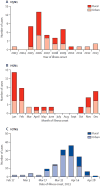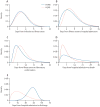Comparative epidemiology of human infections with avian influenza A H7N9 and H5N1 viruses in China: a population-based study of laboratory-confirmed cases
- PMID: 23803488
- PMCID: PMC3777567
- DOI: 10.1016/S0140-6736(13)61171-X
Comparative epidemiology of human infections with avian influenza A H7N9 and H5N1 viruses in China: a population-based study of laboratory-confirmed cases
Abstract
Background: The novel influenza A H7N9 virus emerged recently in mainland China, whereas the influenza A H5N1 virus has infected people in China since 2003. Both infections are thought to be mainly zoonotic. We aimed to compare the epidemiological characteristics of the complete series of laboratory-confirmed cases of both viruses in mainland China so far.
Methods: An integrated database was constructed with information about demographic, epidemiological, and clinical variables of laboratory-confirmed cases of H7N9 (130 patients) and H5N1 (43 patients) that were reported to the Chinese Centre for Disease Control and Prevention until May 24, 2013. We described disease occurrence by age, sex, and geography, and estimated key epidemiological variables. We used survival analysis techniques to estimate the following distributions: infection to onset, onset to admission, onset to laboratory confirmation, admission to death, and admission to discharge.
Findings: The median age of the 130 individuals with confirmed infection with H7N9 was 62 years and of the 43 with H5N1 was 26 years. In urban areas, 74% of cases of both viruses were in men, whereas in rural areas the proportions of the viruses in men were 62% for H7N9 and 33% for H5N1. 75% of patients infected with H7N9 and 71% of those with H5N1 reported recent exposure to poultry. The mean incubation period of H7N9 was 3·1 days and of H5N1 was 3·3 days. On average, 21 contacts were traced for each case of H7N9 in urban areas and 18 in rural areas, compared with 90 and 63 for H5N1. The fatality risk on admission to hospital was 36% (95% CI 26-45) for H7N9 and 70% (56-83%) for H5N1.
Interpretation: The sex ratios in urban compared with rural cases are consistent with exposure to poultry driving the risk of infection--a higher risk in men was only recorded in urban areas but not in rural areas, and the increased risk for men was of a similar magnitude for H7N9 and H5N1. However, the difference in susceptibility to serious illness with the two different viruses remains unexplained, since most cases of H7N9 were in older adults whereas most cases of H5N1 were in younger people. A limitation of our study is that we compared laboratory-confirmed cases of H7N9 and H5N1 infection, and some infections might not have been ascertained.
Funding: Ministry of Science and Technology, China; Research Fund for the Control of Infectious Disease and University Grants Committee, Hong Kong Special Administrative Region, China; and the US National Institutes of Health.
Copyright © 2013 Elsevier Ltd. All rights reserved.
Conflict of interest statement
Figures




References
-
- Gao R, Cao B, Hu Y, Feng Z, Wang D, Hu W, et al. Human Infection with a Novel Avian-Origin Influenza A (H7N9) Virus. N Engl J Med. 2013 - PubMed
-
- Liu D, Shi W, Shi Y, Wang D, Xiao H, Li W, et al. Origin and diversity of novel avian influenza A H7N9 viruses causing human infection: phylogenetic, structural, and coalescent analyses. Lancet. 2013 in press. - PubMed
-
- Han J, Jin M, Zhang P, Liu J, Wang L, Wen D, et al. Epidemiological link between exposure to poultry and all influenza A(H7N9) confirmed cases in Huzhou city, China, March to May 2013. Eurosurveill. 2013;18(20):pii=20481. - PubMed
Publication types
MeSH terms
Grants and funding
LinkOut - more resources
Full Text Sources
Other Literature Sources
Medical

